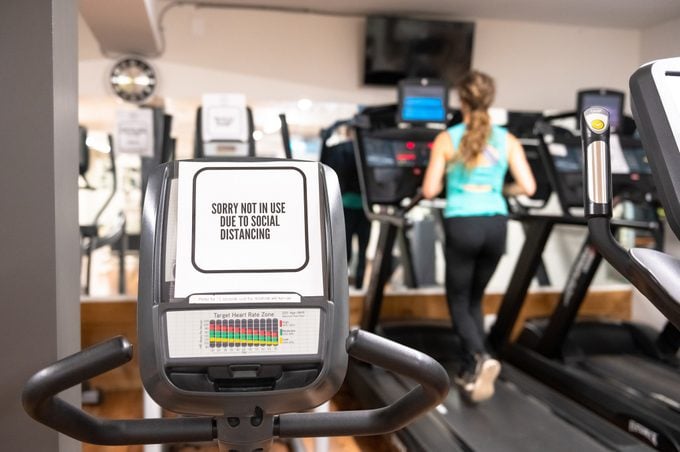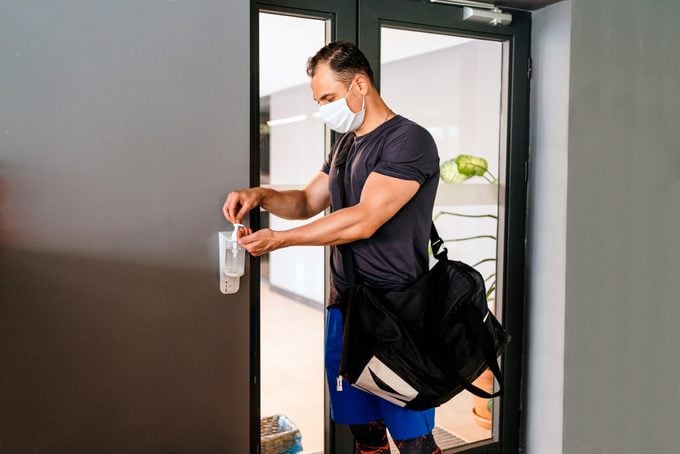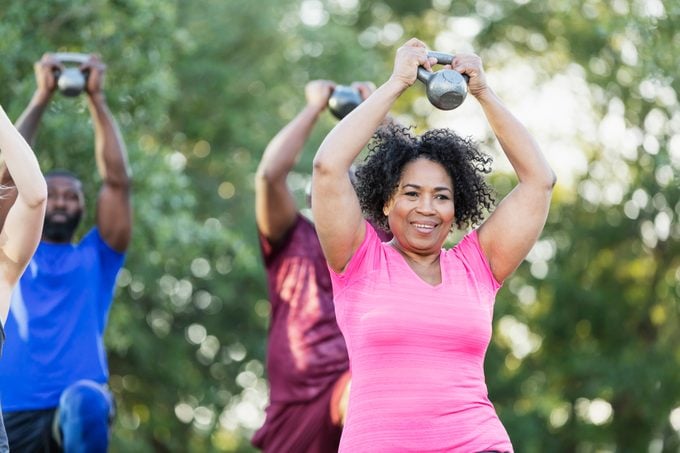How Can I Avoid Covid-19 at the Gym?
Updated: Mar. 14, 2022
In spite of the coronavirus risk, many card-carrying gym members are eager to get back to pumping iron and group fitness classes. Here's how experts say to stay safe while you sweat it out at the gym.
Nationwide, restrictions are lifting as states put coronavirus recovery plans into place, and many people are chomping at the bit to leave their quarantine life behind. People are scheduling long-overdue hair cuts, breaking bread at restaurants with outdoor seating, and swapping out pajamas for spandex as they head back to their regular routines—which may include trips to the gym.
But we’re not out of the woods yet. Because so many people come together in fitness classes and locker rooms, as well as handle common equipment like dumbbells and exercise mats, gyms are one of the riskier places when it comes to possible exposure to the virus that causes Covid-19.
Experts agree we need to exercise caution before we pack our gyms bags and head back. Here’s what to do to lower your risk.

Gym risks vs. benefits
At-home workouts can be just as effective as going to the gym, but motivation can dwindle after a while. You may miss the camaraderie of friends and a class instructor who pushes you to keep going. So how do we balance the risk and benefit of a gym workout?
“Squashing the spread of the disease is imperative, but people also need to take care of their mental and physical health, and fitness is a big part of that,” says Nikita Desai, MD, a pulmonologist at the Cleveland Clinic in Ohio. The amount of risk you’ll tolerate is something each individual must decide based on their personal risk factors. However, you should also keep your fellow gym-goers in mind and take steps to protect other people in case you might be carrying the virus without knowing it. Michael A Ben-Aderet, MD, associate medical director of Hospital Epidemiology at Cedar-Sinai, explains, “It’s really about doing everything you can to reduce risk, knowing the risk can never be completely eliminated.”
The risk is greater for people who are elderly, have compromised immune systems, diabetes, lung disease, and other high-risk categories, or live with a high-risk individual. You should talk with your doctor about whether it is right for you to go to a gym at all, and you may want to consider waiting until there’s a greater decline in cases across the U.S., or until a coronavirus vaccine is available.
The important thing to remember is that just because something is open, it does not mean we should all go there immediately. You must understand your own personal risks and what social distancing and cleaning practices are being used at that facility or business, says Saadia Griffith-Howard, MD, an infectious disease specialist for Kaiser Permanente and its Mid-Atlantic medical director for emergency and disaster management. Be sure to check out Kira Stokes’ Fit App if you’re sticking to at-home workouts.
Ask questions before going back to your gym
Before you lace up your sneakers and update your playlist, call your gym or visit their website to find out what safety measures they are taking to keep you and the staff safe. For example, Dr. Howard says to check with the gym about what specific practices they are rolling out to keep the gym clean. Are they using EPA-approved disinfectants for use against Covid-19—and how often is the gym cleaned? (You can also check the Centers for Disease Control and Prevention for reopening guidance of public places.)
You’ll also want to know how they are screening staff and patrons for illness. Are they using questions or taking temperatures, or both? If you’re at-risk, find out if your gym is setting aside special hours for at-risk clientele who may be coming to the gym for rehabilitation.

Stash these in your gym bag
The following items will help you stick to proper hand hygiene, masking, and disinfection of high-touch surface areas, says Jade Flinn, MSN, RN, an infection prevention and personal protection equipment nurse educator at Johns Hopkins Biocontainment Unit.
- Masks— “Continue to wear masks when in public, including the gym, as they begin to open up at a reduced capacity,” Flinn says. Always keep an extra mask in your bag.
- Hand sanitizer
- Water bottles filled with water from home
- Disinfectant wipes
Don’t bring gloves or goggles. “The use of gloves is not recommended as they can often act as a route for cross-contamination (moving contamination from one object or surface to another),” Flinn says. “Goggles are not necessary if you maintain social distancing, continue to mask, and maintain good hand hygiene.”
And if you don’t already have one, Pamela Aaltonen, PhD, RN, professor emerita at Purdue University, says you might want to invest in your own yoga mat if you’re not confident the mats are properly cleaned after each use.
“If yoga positions require you to put your face on a mat, I would prefer to use my own freshly disinfected mat. The science on the transfer of the virus from a surface to a human is still under investigation and theoretically possible—yet less important than the direct exposure,” says Aaltonen.
If you have a reusable mask, make sure you know how to disinfect it.
Avoid these areas in the gym
One high-risk place to avoid is the locker room. The lockers, dressing benches, showers, bathroom stalls, sinks, and vanity areas are usually in tight quarters. Plus, there’s an abundance of high-touch surfaces and poor ventilation.
“When we talk about locker-rooms, we’re often talking about people who aren’t able to socially distance properly. And I doubt people will be wearing masks consistently while showering,” says Dr. Ben-Aderet. It’s definitely a higher-risk environment. If you’re not avoiding the locker room (and even if you are), be mindful of reducing contaminants once you get home. “Wash your hands before you get in your car. Shower as soon as you enter the house and isolate the workout clothes,” advises Dr. Howard. (Read more about whether washing your gym clothes protects you from coronavirus.)
Swimming pools are another area where social distancing can be a challenge—unless you stay in your lane and stick to swimming laps. “It’s more worrisome when there are large numbers of people in the pool in close proximity, from different households with an unknown number of contacts,” says Dr. Desai.
Keep your gym trip short
In addition to asking about special hours if you’re at risk, ask your gym how long you can stay to work out, advises Aaltonen. Even if your gym doesn’t limit how long you can stay, be aware that your risk of exposure to Covid-19 can increase with prolonged sweat sessions.
“The longer the exposure in a potentially risky environment where there could be someone infected, the greater the probability of being infected,” says Aaltonen. “We don’t have precise science here or definitive answers yet.” Get in and out of the gym in the shortest period possible to obtain the desired result within a period of time that fits with your level of security with the ability to manage risks, Aaltonen recommends.

Opt for outdoor classes
It’s undoubtedly easier to socially distance when you have room to roam. That’s why some gyms are offering outdoor classes. There’s no shortage of respiratory droplets flying around when lots of people are participating in sweaty and packed dance classes like Zuma.
A 2020 study published in Emerging Infectious Diseases revealed 112 people who took fitness dance classes in 12 sports facilities in Cheonan, South Korea, were infected with SARS-CoV-2, the virus that causes Covid-19. Before the facilities closed, that number rose to 217.
The infections were traced to a 4-hour workshop for fitness dance instructors that took place a few weeks earlier. It turned out that 8 of 27 instructors who participated in the workshop had the virus, and they went on to spread the virus in the next week as they taught 50-minute dance classes at a variety of sports facilities.
The researchers think the large classes, small spaces, and intense workouts in a warm, humid environment contributed to the spread the virus. They note that one instructor with the virus did not spread it to people taking Pilates and yoga classes. “We hypothesize that the lower intensity of Pilates and yoga did not cause the same transmission effects as those of the more intense fitness dance classes,” concluded the researchers from Dankook University College of Medicine in Cheonan, South Korea.
“I worry most about situations in which large numbers of people are indoors in an area with poor ventilation, without masks, and where people are coming in close contact with the potential to exchange respiratory droplets,” says Dr. Desai. Even without hard-hitting scientific research, Dr. Desai says outdoor classes with limited participants are probably safer than indoor classes. But is a mask still necessary for outdoor classes? “Wearing a mask would be superior to not wearing a mask in terms of infection control,” Dr. Ben-Aderet says.
That may be difficult to do when you’re breathing heavily. If that’s the case, Dr. Ben-Aderet adds that if you are appropriately socially distancing, the chances of spreading the respiratory droplets to someone without a mask is low. “If people are farther from six feet from each other, that’s really beyond the area a respiratory droplet can spread, so the risk is probably much lower in that case.”
Follow coronavirus gym etiquette
Covid-19 has pushed gym etiquette to another level. Even though gyms are expected to properly clean their equipment, it’s critical to be conscientious of wiping down the cardio machines, mats, dumbbells, and other equipment before and after each use.
Spotting another person lifting weights may be too close for comfort for some people. Still, if you choose to spot someone, Aalatonen says if both people are wearing masks that fit correctly and are used correctly, the risk decreases but is not totally eliminated.
It’s going to be tough, especially if you sweat a lot, but Flinn recommends that you avoid touching the area around the eyes and nose—you could transfer the virus from potentially contaminated hands. And you’ll have to replace the congratulatory high-fives with a socially distant thumbs-up. (Next, check out the 16 things everyone is looking forward to once social distancing ends.)
